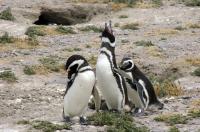
Three Magellanic penguins in the new marine park declared by Argentina on Aug. 8. Over half a million of these marine birds will call home to this new protected area. The Bronx Zoo-based Wildlife Conservation Society announced today that the government of Argentina will create a new marine park along its isolated and windswept Patagonia coast to safeguard more than half a million penguins and other rare seabirds. Located in Golfo San Jorge, the new protected area covers around 250 square miles (647 square kilometers) of coastal waters and nearby islands strung along almost 100 miles (160 kilometers) of shoreline.
The announcement was made by President Nestor Kirchner of Argentina, the Governor of the Province of Chubut—Mario Das Neves—and by Argentina’s National Park Service. The park’s creation represents a joint effort by the Government of Chubut, the National Parks Service of Argentina, the Wildlife Conservation Society and the Fundación Patagonia Natural.
“This decision represents a significant commitment by the government to protect one of the most productive and extraordinary marine ecosystems on the planet,” said Dr. Guillermo Harris, director of the Wildlife Conservation Society’s Argentina Program. “The creation of this park comes in the nick of time for many species that are threatened by the region’s fisheries and energy industry.”
The new park serves as a nesting and feeding ground for some quarter million pairs of Magellanic penguin, estimated to represent 20 percent of the entire species. The park includes more than 40 small islands, which support the only two nesting colonies of southern giant petrels on the entire Patagonian coast, as well as the only colonies of Southern American fur seals. Other denizens of this coastal oasis include the endangered Olrog’s gull, the white-headed steamer duck, and almost a quarter of all imperial and rock cormorants of Argentina.
While the coastline is largely undeveloped, its wildlife is under pressure from a number of threats, including Argentina’s commercial shrimp industry. Many birds become entangled in fishing nets, and oil pollution from tankers transporting petroleum from southern Patagonia to Buenos Aires and from expanding offshore oil drilling operations is a looming possibility.
Legislation to formally create the protected area will be drafted in the next few months and approved by the Argentine Congress and local legislators.
WCS has been active in Patagonia since the 1960s, conducting studies for the conservation of southern right whales, Magellanic penguins, southern elephant seals and other unique wildlife species. WCS also recently became the owner of Karukinka a protected area of over half a million acres in southern Chile on Tierra del Fuego – a gift of Goldman Sachs in 2004 – which contains some of the world’s last remaining wilderness areas at the southernmost tip of South America..
Source : Wildlife Conservation Society
 Print Article
Print Article Mail to a Friend
Mail to a Friend
